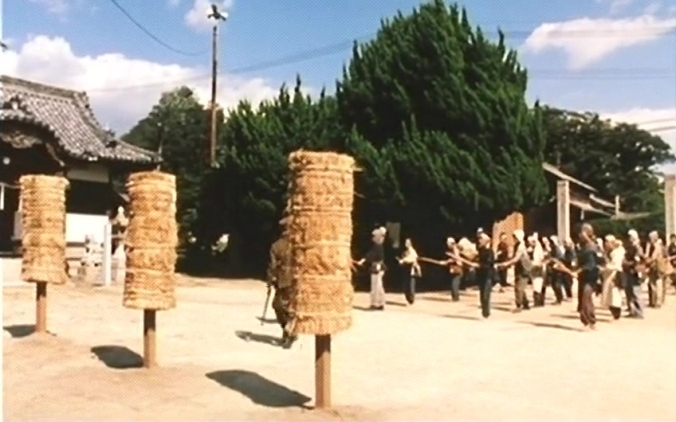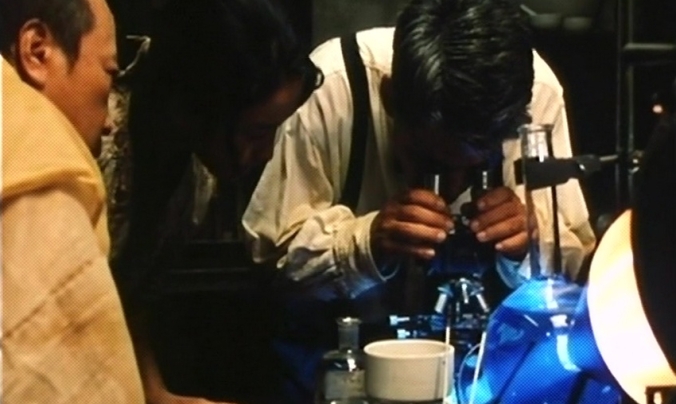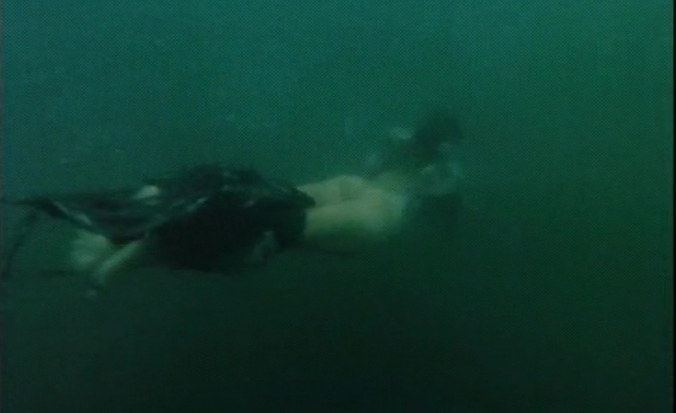 Akagi is a doctor on the coast on the outskirts of Hibi, itself only a small port in the south of Japan. As a “family doctor,” he is always on the run from house to house to treat his patients, and our most common vision of him is running in his white suit with knee pants and a straw boater. He has an obsession with hepatitis, which he finds in most of his patients, so often in fact that he is called Doctor Liver, the Japanese title of Imamura’s movie.
Akagi is a doctor on the coast on the outskirts of Hibi, itself only a small port in the south of Japan. As a “family doctor,” he is always on the run from house to house to treat his patients, and our most common vision of him is running in his white suit with knee pants and a straw boater. He has an obsession with hepatitis, which he finds in most of his patients, so often in fact that he is called Doctor Liver, the Japanese title of Imamura’s movie.
Around Akagi we see the most detailed recreation of common Japanese life at the end of the war that I have found, from the announcement in May that Germany has surrendered to the day of the Hiroshima bombing in August. The detail is so dense it is difficult to know where to start. We see rationing lines, shortages in medical supplies, the disappearance of white rice, the spread of an ill-understood disease that is untreatable in current circumstances – Akagi is called on the carpet by military authorities for prescribing rest and good food, neither of which is possible when the army needs every scrap of food and supplies it can lay its hands on as everyone looks toward the advance of the Americans.  In the background, we see women training at bayonet charges using only sharpened bamboo spears, indicating both a lack of forces to repel any invasion and a willingness to continue to fight anyway. Though there are air raid alerts and shelters, the town itself has been spared any serious bombing because the factory at its center is manned by American, British, and Dutch POWs. The local military police are paranoid and convinced there is a spy somewhere in the vicinity.
In the background, we see women training at bayonet charges using only sharpened bamboo spears, indicating both a lack of forces to repel any invasion and a willingness to continue to fight anyway. Though there are air raid alerts and shelters, the town itself has been spared any serious bombing because the factory at its center is manned by American, British, and Dutch POWs. The local military police are paranoid and convinced there is a spy somewhere in the vicinity.
Akagi has a surgeon friend who is fully aware that the war is lost and has taken to morphine to keep himself going. The beautiful Tomiko has a guest house, but the local military officer has shut it down, claiming typhus among the staff. This is not true, but simply his attempt to get Tomiko into bed with him. The bonze has a mistress he can’t keep his hands off of but is still a friend who helps protect Akagi in several significant activities. A young man working for the local government has been embezzling funds to pay a prostitute with whom he has fallen in love. In his fear of a firing squad, he goes mad, shaves his head, and tries to become a monk. Akagi has a son serving as a military doctor in Manchuria, whom he will eventually learn has died.*
Most prominent and interesting is Sonoko, the young prostitute with whom the clerk has fallen in love. She has a husband somewhere overseas, but she also has siblings to support. Akagi offers her a job as his assistant, but this pays far less; when she brings food for her sleeping kin, she finds a note begging her to “go back to whoring” because they are so hungry. The one thing she remembers from her mother, who also spent time as a prostitute, is “no freebie lays” except for your one true love. She soon decides that Akagi is that love, but he refuses all her offers.
Most Japanese movies abut this era focus on TB as the major killer disease, so this is the first time I have seen mention of hepatitis. For much of the movie, it looks as if we are seeing another story of the dedicated researcher who against all odds finally discovers the magic Cure. Though seeing himself as a not very successful GP in the middle of nowhere, he was one of the intellectual leaders of his class, going on for additional study in Germany. As the military hospital closes down, he is given a microscope at last. He has documented 1500 case studies that he presents to a reunion in Tokyo to much acclaim and at the same time manages to find a much stronger lens. The projector in the local movie theater breaks down, so the projectionist helps him adapt the arc lamp to provide more light. An escaped Dutch prisoner who has ended up at Akagi’s for treatment turns out to have been an optical engineer and helps focus the light properly. But it is not to be – the arc lamp is so strong that light leaks through the curtains. The military think it is the spy signaling and in the ensuing raid capture the prisoner, destroy all the equipment, and arrest Akagi, his surgeon friend, the priest, and the projectionist. Tomiko at last sleeps with the officer to gain Akagi’s release before he is beaten to death, and the surgeon is killed in an attempt to raid the military pharmacy for more morphine.
But it is not to be – the arc lamp is so strong that light leaks through the curtains. The military think it is the spy signaling and in the ensuing raid capture the prisoner, destroy all the equipment, and arrest Akagi, his surgeon friend, the priest, and the projectionist. Tomiko at last sleeps with the officer to gain Akagi’s release before he is beaten to death, and the surgeon is killed in an attempt to raid the military pharmacy for more morphine.
In summary, all of this sounds quite earnest, like The Story of Louis Pasteur, but it is told with the broad and earthy humor that Imamura had been noted for in earlier years. Ikagi is always on the run from one house to another, first seen disturbing a soldier who is trying to convince a woman to have sex because “we’re all going to die soon anyway.” Sonoko fills in for an ill “geisha” for a party where they most definitely do not entertain in the carefully trained geisha manner and afterwards does a posing session for a man who wants to take photos of her vagina, including inserting a hardboiled egg that he eats afterwards.
Later, she refuses to eat any more eggs. Needing a fresh sample of a liver for his microscope, Akagi and the priest dig up the body of a man who has just died, the priest sitting on the grave praying while the body is carried off for dissection.
Sonoko was always told that her father had killed a whale. When she and Akagi are on the way back from a patient on a nearby island, she spots a whale in the bay. She harpoons it to give to Akagi but only has a length of rope to hold onto as it pulls her underwater. At last out of air, she lets go and surfaces, then helps Akagi back into the boat as they watch the whale swim off in the morning light, altogether an absolutely magical scene.
Unfortunately, it is also August 6th, and while they right themselves in the boat as the whale swims away, they see a strange mushroom cloud appear farther inland. Akagi hallucinates it as an angry liver, but Hiroshima is on the other side of the same peninsula.
All told, it is a remarkable movie, a detailed period recreation and a character study of a serious man still told in an engrossing and most entertaining manner.
* Akagi’s son dies of an illness, rather than from wounds. Akagi has a nightmare in which he tells the son to stop, without knowing what it is he should stop. But the son’s letters are posted from Harbin, indicating the young man was involved in the experiments on live humans conducted there.


Pingback: All My Children / Minna waga ko (1963) | Japanonfilm
Pingback: Another Heaven / Anuzahevun (2001) | Japanonfilm